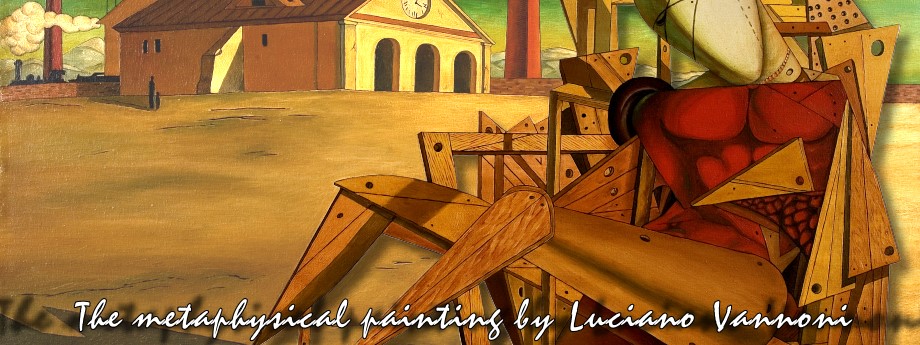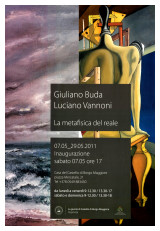 |
|||
 |
|||
|
|
THREE PAINTERS IN SAN LEO […] Luciano Vannoni reminds us of Giorgio De Chirico, one of the most popular 20th century artists, bringing him back to life again. He plunges into De Chirico’s technique as a bee would do with flowers. He gets into the painter’s artistic vein learning the architectural secrets and varying the several and solemn colours which palpably remind of the master’s style. In such a way he puts up the same buildings, dummies and visceral bodies in physics, in a hard static turn of mind, darkening them in doughy, thick and solid colours, without any crack. This proves that De Chirico’s striking style, with his own knowledge, journeys and volumetric fancy, can still be a model for future painters.. Milena Massani
THE TRADITION AND RESEARCH […] A different case is Luciano Vannoni’s one. He is so fond of metaphysical art, that he develops an interest in such difficult and fascinating painter as De Chirico. That is, Vannoni has created some sketches of the popular “Italian Squares”. He has imagined them in such a good way that the result is flawless, highly mimetic, as a real demiurgic action, like a minor god giving life to the major god’s project. The artist maintains that his interest in metaphysics originated from the fact that, when he was a teenager, he had attended some lessons at the old Rimini Seminary, he felt that the building was both a playground and a mystical place. Ivo Gigli
|
THE METAPHYSICS OF REAL
Luciano Vannoni’s pictures are the figment of the recognition or identification of something unknown till then, as concealed by the memory’s folds. In an essay, Flannery O’Connor claims if a writer “has survived his childhood has enough information about life to last him the rest of his days”[1]. Even when not working with the real subjects, the footprints of those items set in the artist’s soul. He fills them out as moulds of miss works so they don’t remain meaningless. The childish memories has drawn Luciano Vannoni up to a painting similar to De Chirico’s art. His way to understand the real has been shaped by the ambiance he breathed when he was a child in the ancient seminary in Rimini where he used to spend longtime playing games. When he firstly saw De Chirico’s works in 1971, these caused him a sort of emotional short-circuit. Those empty spaces where enigmatic threads intertwine each other became a wonderful obsession to summon with the ebullient power of childish fascination. He found out twenty-four sketches up thirty performed by De Chirico in 1917 during the stay in Villa del Seminario in Ferrara[2] had never been realized oil-painted. Vannoni decided to transpose on the canvas those drawings, recovering De Chirico’s techniques. Not only. De Chirico claimed the discovery of the past is not possible without the discovery of the present. He believed the melting pot of the ancient and modern could bring the limits imposed by the culture down. To Vannoni, the past is both historical and close. Both them have a dialogue with the here and now of the expressive urgency. The art focuses again on a spiral-shaped movement and reveals itself to the world through the recognition of a common feeling.
[1] Flannery O’Connor, Mystery and Manners: occasional prose, Paperback, 2000. [2] In-depth news, on website www.pitturametafisica.it
Maria Chiara Monaldi |
|
|
BIOGRAPHY - LATEST PRODUCTIONS - THE PICTORIAL CREATIONS - DRAWINGS - MY METAPHYSICAL ISPIRATIONS - COPIES OF DE CHIRICO'S PAINTINGS - SUMMARIES - CONTACTS - LINKS |
|||
